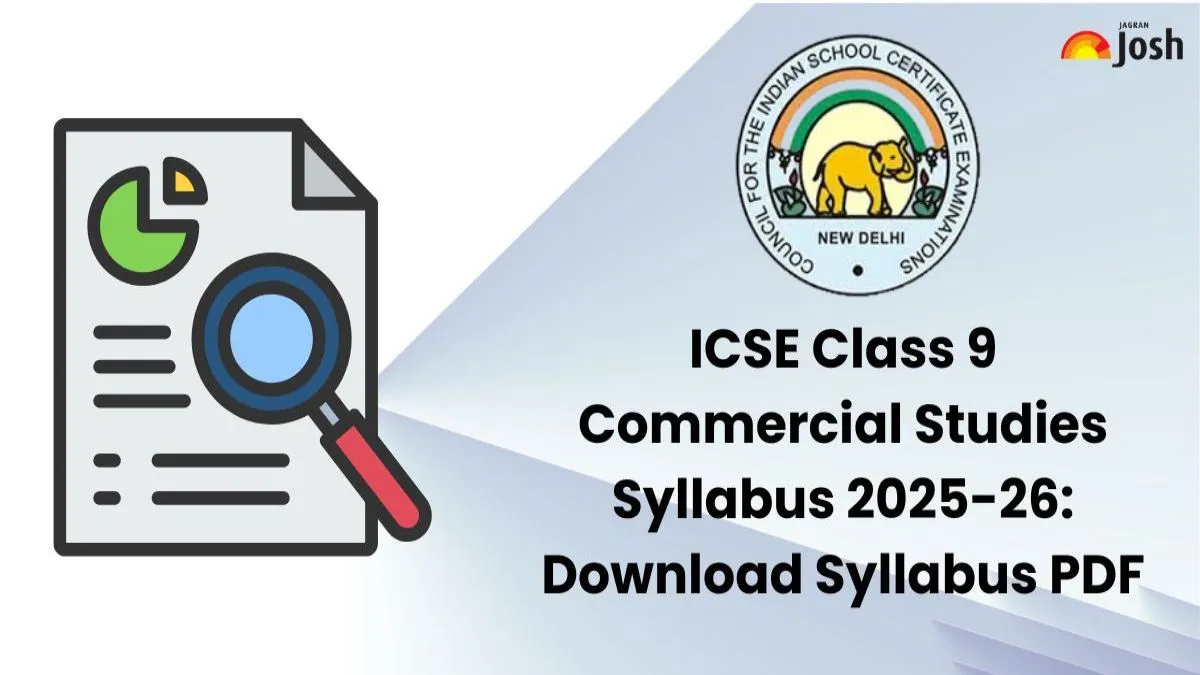ICSE Class 9 Commercial Studies Syllabus 2025-26: The CISCE class 9 Commercial Studies syllabus focuses on teaching students the basic concepts in Commercial Studies, which is an important subject for further classes. The goal of this introductory course is to foster critical thinking abilities and spark an interest in Commercial Studies.
The curriculum helps students develop a solid foundation in Commercial Studies by covering both theory and practicals. Students will have a foundational grasp of Commercial Studies at the end of the course, which will prepare them for more complex subjects in later grades. Read this article for the most up-to-date and comprehensive details on the ICSE 9th Commercial Studies syllabus. The syllabus is available for free download as a PDF.
ICSE Commercial Studies Syllabus 2025-26: Aims of the course
1. To enable students to develop a perceptive, sensitive and critical response to the role of business in a global, national and local context.
2. To allow students to balance the demands of social parameters with individual aspirations.
3. To develop in students an appreciation for the roles of the entrepreneur and the professional manager.
4. To help develop a co-operative attitude through study of the organisation and participation associated with commerce and industry.
5. To provide an appropriate body of knowledge and understanding, and to develop appropriate skills as a basis for further study or work or both.
ICSE Class 9 Commercial Studies Syllabus 2025-26: Important Guidelines:
1. There will be one written paper of two hours duration carrying 80 marks and an Internal Assessment of 20 marks.
2. The paper will be divided into two sections, A and B.
3. Section A (Compulsory) will consist of questions requiring short answers and will cover the entire syllabus.
4. Section B will consist of questions, which will require detailed answers. There will be a choice, and candidates will be required to answer four questions from this section.
ICSE Class 9 Commercial Studies Syllabus 2025-26
Students can check the complete syllabus below for the commercial studies:
| 1. Commercial Activities |
| (a) Commercial and Non-Commercial Activities Meaning and difference with examples. (b) Types of Commercial activities. Business, profession and employment – meaning and features. (c) Business Activities Meaning and characteristics. Types of business activities: industry and commerce; classification of industry (primary, secondary and tertiary – meaning and examples of each). (d) Non-profit Organisations Meaning and types (Society, trust, and non-profit companies - Meaning and Examples only). (e) Commerce Meaning of Commerce and its Classification: (i) Trade (types of trade: wholesale and retail, domestic and foreign, e-commerce & e-trade - meaning and examples of each. (ii) Aids to trade: transport, banking, advertising, insurance, warehousing, packaging – meaning and examples of each. (f) Commercial organisations - Classification on the basis of ownership. (i) Private Sector enterprise - Sole proprietorship, Partnership, one-person company, Joint-stock company, Limited liability partnership, Co-operative society (Meaning and features only). (ii) Public sector enterprise – Departmental undertaking, public corporation, and government companies (Meaning and features only). (iii) Joint Sector Enterprises – Meaning, features only. |
| 2. Important departments of a Commercial Organisation |
| (a) Production (b) Purchasing and Stores (c) Marketing and Sales (d) Finance and Accounting (e) Human Resources (f) General Administration, Legal and Compliance (g) Management Information System (MIS) Meaning and objectives of each of the above |
| 3. Communication in Commercial Organisations |
| Meaning and process; role of communication in a commercial organisation; different methods of communication: letter, e-mail, conference calling (audio & video), telephonic conversation, social media – meaning of each. |
| 4. Introduction to Accounting and Bookkeeping |
| (a) Meaning and objective Meaning of accounting and bookkeeping; the objective of accounting; the accounting cycle; the distinction between accounting and bookkeeping. (b) Basic accounting terminology Capital, liability, asset, revenue, expense, purchase, sales, stocks, debtors, creditors, drawings, debit and credit, discount (Meaning only). (c) Basic accounting principles and concepts. Business entity, money measurement, going concern, accounting period, dual aspect and accounting equation, matching principle, principle of full disclosure – meaning and examples. (d) Journal Meaning of Journal; and classification of accounts, rules of debit and credit. Recording of transactions in the journal. (Simple numerical based on the terminology mentioned in part (b) need to be covered. Compound journal entries, including cash discount, bad debts and opening and closing entries need not be covered. (e) Ledger Meaning, posting and balancing of ledger accounts. (Ledger posting on the basis of simple journal entries). (f) Trial balance Meaning, objectives and preparation of trial balance with the given set of ledger account balances. (Redrafting of trial balance need not be covered.) (g) Cash Book Meaning, types of cash books, preparation of single-column cash book |
| 5. Banking |
| Commercial Banks - Functions and Types of Accounts (Savings, Current, Recurring & Fixed Account – meaning and difference only). |
| 6. Trade |
| (a) Channels of distribution Physical - C & F Agents, Wholesalers, Distributors & Retailers (meaning only). (b) E-commerce & E-trade Merits and demerits of online trading. |
| 7. Social Responsibility of Commercial Organisations towards the Environment |
A brief understanding of the above. |
| INTERNAL ASSESSMENT |
| A minimum of three assignments are to be done during the year, as assigned by the teacher. |
Get the complete syllabus in PDF format from the link below:
Other Related Links
